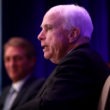 When Oregon governor John Kitzhaber needs to get away from the stresses of work, he heads to the Rogue River and rafts the great whitewater rapids that churn through its canyons. In calmer waters, he fly-fishes. “It’s my church,” the 65-year-old politician explains. “You’re in the moment. Ospreys, eagles, bears. It’s the most spiritual place you can imagine.”
When Oregon governor John Kitzhaber needs to get away from the stresses of work, he heads to the Rogue River and rafts the great whitewater rapids that churn through its canyons. In calmer waters, he fly-fishes. “It’s my church,” the 65-year-old politician explains. “You’re in the moment. Ospreys, eagles, bears. It’s the most spiritual place you can imagine.”
Unlike most politicians of his generation, Kitzhaber is comfortable talking about the “commons,” both environmental and fiscal. “The [social] contract,” he says, “is on the one hand that we live in this wonderful, free society. But we have an obligation to ensure each has the same opportunity that we do. We are in it together; we are interdependent.”
There’s a risk that this language can come off as touchy-feely. When the governor talks, however, he does so with authority. “His interests, skills, and abilities seem to perfectly align around public policy endeavor,” says Mark Gibson, Kitzhaber’s onetime chief of staff and now director of the Center for Evidence-Based Policy in Portland. “He works well in a leadership role. He wouldn’t be a particularly successful or happy Congressional member.”
Kitzhaber argues that we have to “replenish natural resources rather than deplete them.” Instead of pushing for limitless economic growth, he’s more comfortable discussing “economic reinvention.”
Kitzhaber, who is divorced, now lives with green-energy consultant Cylvia Hayes. He has a 14-year-old son; and perhaps because he’s focused on the well-being of a youngster, he’s seeking economic models that won’t wreck the environment that today’s young people will grow up in. “We have to fundamentally rethink the tools and opportunity pathways by which we provide economic opportunity.”
John Kitzhaber was born in Colfax, Washington, when his parents were graduate students at the state university there. As his mother and father moved up the academic ladder, his family moved to Portland, then east to New Hampshire, then back west to Eugene.
He attended Dartmouth, where in the mid-to-late 1960s he studied biology, grew increasingly political as the tumultuous events of that decade unfolded, and nurtured an interest in medical research—especially studies of artificial vision. “I had several friends who were blind. I couldn’t imagine a worse thing to happen than not to be able to see the glory of the world around us,” he explained.
Kitzhaber then went to medical school and afterward began working as an emergency room doctor in the little mill town of Roseburg, Oregon. In the late ’70s, Kitzhaber won a seat in the Legislature—a part-time position he held while continuing with his ER work. During the 34 years that have followed, he has served as the Oregon Senate president and as a thrice-elected governor.
Kitzhaber has built up a reputation as one of the country’s most strongly pro-environmental governors. He has worked on rehabilitating salmon runs, opposes expansion of coal exports, and has brought landowners and environmentalists together in a series of innovative watershed committees to voluntarily self-police water usage. “People do it not because they have to but because it makes sense,” the governor avers, as he explains his vision of how conservationist water-management decisions could proceed.
What makes Kitzhaber’s story so compelling is that this is his second go-around as governor. The first time, in two terms from 1995 to 2003, his agenda fell victim to vitriolic partisan politics. Opponents sneeringly referred to him as “Dr. No,” a man who couldn’t pass his own legislation and resorted instead to vetoing that of the Republican majority. When he left office, termed out and embittered, he was widely reported as saying that Oregon, caught in the vise of hyper-polarization, was on the verge of being ungovernable.
The state was battered by the bursting of the dot-com bubble and the post-2001 recession that followed. The budget deficit was soaring, and neither party could find a route to compromise to rein it in. Caught in a stalemate, unable to increase property taxes—because voters had elected to limit the tax—the state resorted to stark cuts to education, mental health services, and vital public safety functions.
Oregon was making national headlines for bad reasons, including drastic cuts to the length of the school year, an erosion of basic curriculum requirements, and a public-employee retirement system facing enormous unfunded liabilities. Kitzhaber left office in 2003 with a few big-picture reforms under his belt.
This time around, however, since being re-elected in a cliffhanger in 2010—Oregon’s term-limit law bans a person from serving three consecutive terms as governor—Kitzhaber has been light years more successful at getting key legislation passed. And he has done so despite, or arguably because, he is now governor of a state with a tied legislature—each party has 30 members in the state House. In fact, in the nearly two years since he took the oath of office, Kitzhaber and his partners in the Legislature have managed to craft a record that ranks as one of the most productive and far-reaching in Oregon history.
How did he do it? The day after Kitzhaber was elected to his third term, when it became clear that the House was deadlocked 30–30, he phoned the leaders of both parties and suggested they get together for a meeting at Mahonia Hall, the governor’s residence.
“My perception of his style, right off the bat, was inclusive,” says GOP House co-Speaker Bruce Hanna. “This governor came to the Republican caucus multiple times. It’s a level of accessibility that we’ve not seen.” Hanna’s Democratic partner, co-Speaker Arnie Roblan, agrees. Roblan says he is “very impressed with his willingness to listen and to talk to a lot of people. After the election he reached out to all sorts of caucuses in the House.”
Improbably, the strategy worked. Brought together by Kitzhaber, Roblan and Hanna developed what Duncan Wyse, president of the Oregon Business Council, called “a magic in those relationships.”
Instead of being overwhelmed by a fiscal crisis that had ballooned the state’s deficit to $3.5 billion following the 2008 financial collapse—many times what it had been in 2003, when Kitzhaber found it so difficult to fund basic services—the Legislature passed a balanced budget. This was in stark contrast to the paralysis that California fell into as its budget deficit soared. In Oregon, by getting both parties to agree to deliver sixteen votes to pass any budget bill, equitably spreading political risk, the governor avoided a budget stalemate.
Kitzhaber’s agenda extended beyond the budget. Instead of looking at Oregon’s dismal graduation rates and kicking the problem down the road, the Legislature enacted the governor’s 40–40–20 plan. It creates a 10-year budgeting process for education, and aims at a 100 percent high-school graduation rate by 2025, with 40 percent of graduates going on to a four-year college and another 40 percent to two-year degrees.
The reforms, which required a waiver from the Bush-era No Child Left Behind law, envision education as a seamless system that begins in preschool and ends in college, a 0–20 strategy based on the idea that unless you give kids opportunities early, they will have to play catch-up for the rest of their time in school. The governor told his education team that the old system, which underemphasized preschool, was like allowing babies to be thrown into a river and then having to run downriver to pick them up. Why not stop them falling into the water in the first place?
At the urging of his education adviser, Nancy Golden, Superintendent of the Springfield School District, Kitzhaber called for open enrollment across school district lines, encouraged the creation of charter schools, and established a set of broad-based measures of teacher success. He also created an Oregon Education Investment Board, with the authority to determine how and where to spend money and to decide which parts of the education system need an emergency injection of resources. At each stage of the process, from preschool through college, Achievement Compacts were put in place between educational institutions and the state. Unlike No Child Left Behind, which mandates absolute standards, Oregon’s system takes into account the varied economic environments that children come from and that schools operate within. It is, in other words, chock-full of nuance.
Kitzhaber also appointed Rudy Crew, a noted reformer who had directed New York City and Miami’s public schools, as Oregon’s first chief education officer.
And, since Kitzhaber has always thought holistically—“he’s known as a tremendous systems person,” Golden explains—the state began bringing healthcare facilities into schools. It’s a change long campaigned for by education reformers such as the Economic Policy Institute’s Richard Rothstein, who wrote Class and Schools: Using Social, Economic, and Educational Reform to Close the Black-White Achievement Gap. Rothstein and other reformers have argued that deceptively simple measures, such as situating opticians in low-income schools, could do more for kids’ academic attainment than a host of more expensive curriculum and institutional reforms.
Kitzhaber has also returned to the health care reform agenda that he began promoting in the ’80s when he was president of the Senate. While Republican governors closed ranks in opposition to the Affordable Care Act, the Oregon Democrat got the Legislature to create a network of Coordinated Care Organizations. Then he convinced the federal government to invest $1.9 billion to help Oregon transition to the new model, on the promise that the feds would more than get their money back through the state’s taming of Medicaid costs, a large part of which are picked up by the federal government. Already, 15 such centers are up and running, covering most of the state’s Medicaid population, with more on the way.
Instead of turning a blind eye to soaring Medicaid costs and insurance premiums the state picks up for public employees, Kitzhaber proposed reform measures. They include caps on spending that are intended to reduce costs while increasing the overall health of Oregon’s population—both through emphasizing preventative care and by setting up social-work networks with the power to go far beyond traditional medical responses in helping people catch sickness early (or avoid it altogether).
Since a small group of patients account for 80 percent of all medical expenditures, finding ways to affordably improve their health could have huge pay-offs. Kitzhaber uses an example of the person suffering from congestive heart failure: Each time she has to be admitted to a hospital, it costs on average $50,000. If the patient is elderly, and too poor to buy an air-conditioner, on a very hot day she might become so ill that she ends up in the hospital.
Why not instead have a community health worker visit her at home, asks Kitzhaber, and authorize the Coordinated Care Organization to pay a few hundred dollars to purchase and install an air conditioner.
It makes more sense than the current model, which provides no aid until the patient is sick enough to need a multi-thousand-dollar hospital intervention. “The purpose of the healthcare system is not just to finance medical care, it’s actually to make people healthy,” Kitzhaber argues. “Ninety percent of what makes you healthy has nothing to do with healthcare.”
He estimates that the savings to be gained over 10 years, simply from moving teachers into Coordinated Care health networks, could amount to $5 billion, allowing Oregon to refocus on preschools and the early grades, as well as boosting high school graduation rates.
“One of the elements we’re missing today is a sense of common purpose,” he argues. “It’s the glue that holds us together, allows us to act together as a community in the general interest.” Without that glue, “then it becomes a politics of scarcity, a zero-sum situation where there’s always a winner and a loser. We’ve forgotten we have anything that we share.”
Seeking to rebuild that common sense of purpose, Kitzhaber has put in a huge effort to bring a spectrum of political figures to the table to tackle the biggest-picture problems facing his state. “We created a space for people to come together around a common purpose.” You get things done, he continues, “if you change the frame of the debate and get out of the partisan mode.”
Lots of politicians talk about bridging the partisan divide. Few, however, have been able to deliver. Kitzhaber is the exception. On issue after issue, over the past two years, he has managed to produce reform.
“It’s not about going back,” the three-time governor declares. “It’s about creating something new; being willing to lose; having willing partners in both parties.” His ideal, he says, is to further “some goal that transcends ourselves as individuals, that we are all committed to. I call it trickle-up leadership.” He believes that if it works, other states will follow.
Sasha Abramsky is the author of several books, including Inside Obama’s Brain and Breadline USA: The Hidden Scandal of American Hunger and How to Fix It. For more information, visit his website.
Also in this issue: Lou Dubose introduces Sasha Abramsky’s article as part of our “What Works” series. Be sure to also check out Union Dues and Dr. Yes.





0 Comments